ACC03043 - Corporate Governance: Corporate Collapses & Governance
VerifiedAdded on 2022/11/14
|5
|1228
|189
Report
AI Summary
This report examines corporate governance failures through the lens of historical corporate collapses in Australia, including Bond Corporation, Rothwells Ltd., and Girvan Corporation, highlighting issues such as inadequate control measures, misuse of power, and conflicts of interest. It also explores the corporate governance implications stemming from the global financial crisis of 2008, focusing on loosened lending standards, weak ethics, and complex financial products. The report concludes by discussing the evolution of corporate governance practices, including enhanced regulations, risk management processes, and the importance of independent directors, to mitigate the risks of future corporate failures. Desklib offers this and similar solved assignments to aid students in their studies.
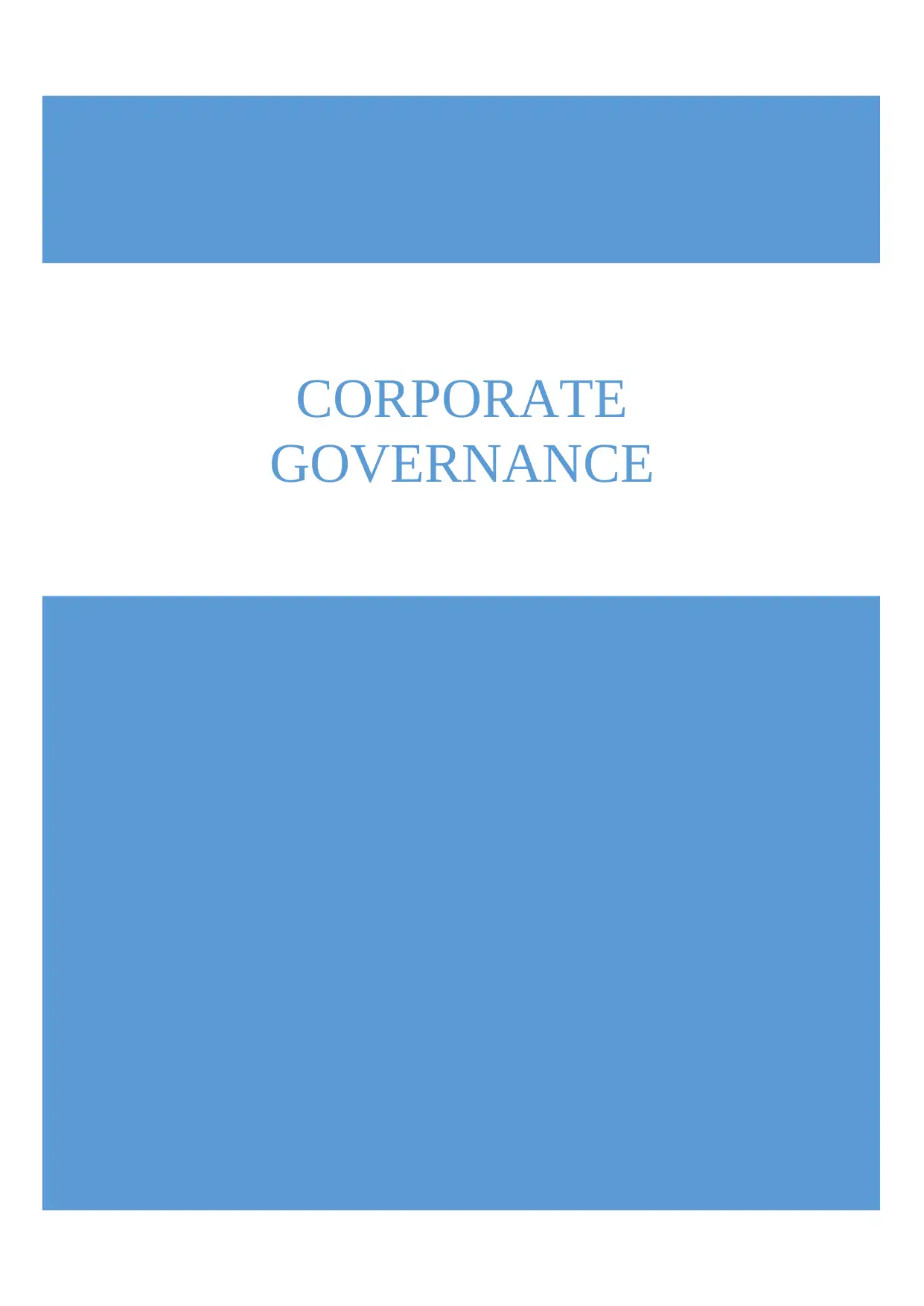
CORPORATE
GOVERNANCE
GOVERNANCE
Paraphrase This Document
Need a fresh take? Get an instant paraphrase of this document with our AI Paraphraser
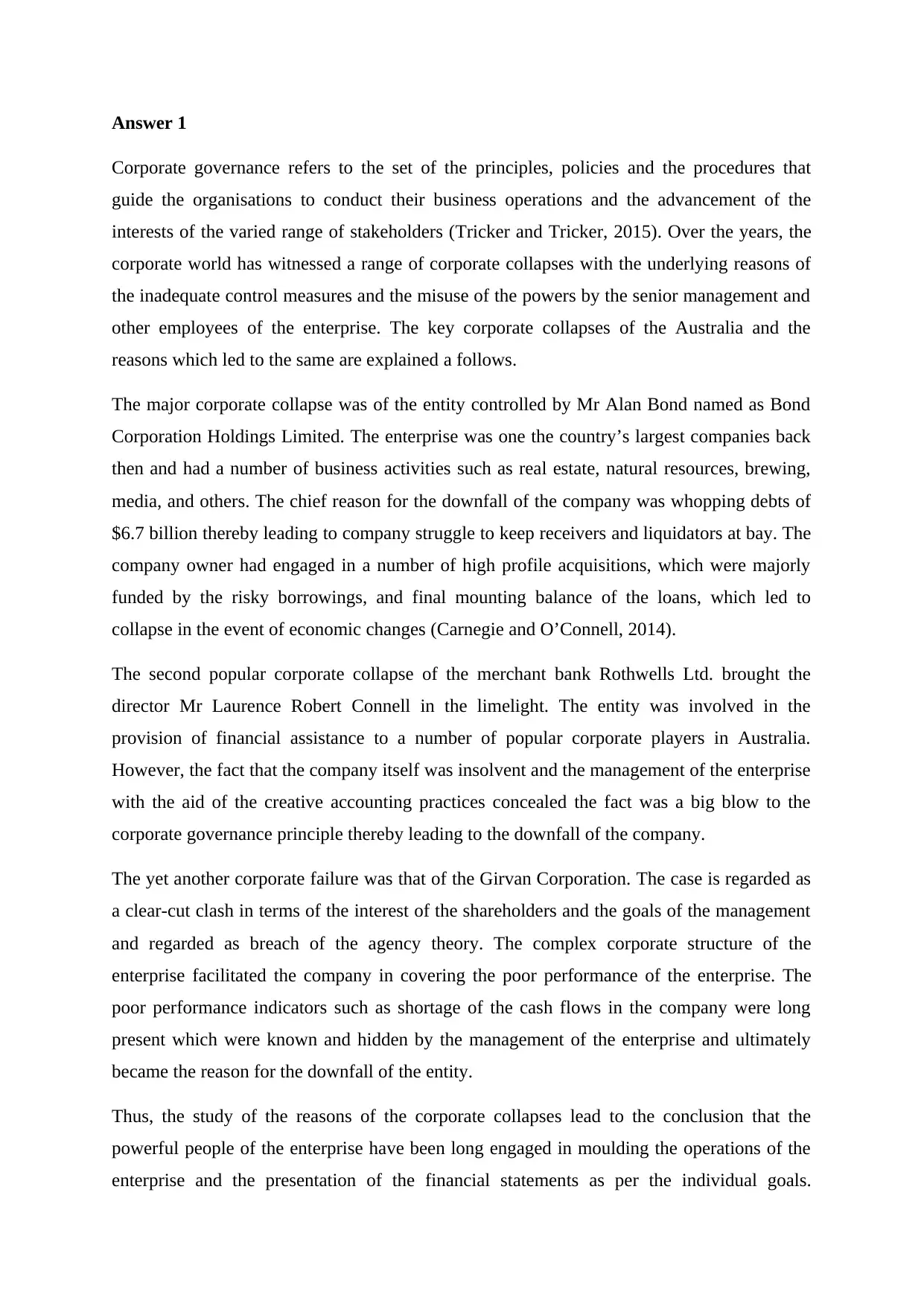
Answer 1
Corporate governance refers to the set of the principles, policies and the procedures that
guide the organisations to conduct their business operations and the advancement of the
interests of the varied range of stakeholders (Tricker and Tricker, 2015). Over the years, the
corporate world has witnessed a range of corporate collapses with the underlying reasons of
the inadequate control measures and the misuse of the powers by the senior management and
other employees of the enterprise. The key corporate collapses of the Australia and the
reasons which led to the same are explained a follows.
The major corporate collapse was of the entity controlled by Mr Alan Bond named as Bond
Corporation Holdings Limited. The enterprise was one the country’s largest companies back
then and had a number of business activities such as real estate, natural resources, brewing,
media, and others. The chief reason for the downfall of the company was whopping debts of
$6.7 billion thereby leading to company struggle to keep receivers and liquidators at bay. The
company owner had engaged in a number of high profile acquisitions, which were majorly
funded by the risky borrowings, and final mounting balance of the loans, which led to
collapse in the event of economic changes (Carnegie and O’Connell, 2014).
The second popular corporate collapse of the merchant bank Rothwells Ltd. brought the
director Mr Laurence Robert Connell in the limelight. The entity was involved in the
provision of financial assistance to a number of popular corporate players in Australia.
However, the fact that the company itself was insolvent and the management of the enterprise
with the aid of the creative accounting practices concealed the fact was a big blow to the
corporate governance principle thereby leading to the downfall of the company.
The yet another corporate failure was that of the Girvan Corporation. The case is regarded as
a clear-cut clash in terms of the interest of the shareholders and the goals of the management
and regarded as breach of the agency theory. The complex corporate structure of the
enterprise facilitated the company in covering the poor performance of the enterprise. The
poor performance indicators such as shortage of the cash flows in the company were long
present which were known and hidden by the management of the enterprise and ultimately
became the reason for the downfall of the entity.
Thus, the study of the reasons of the corporate collapses lead to the conclusion that the
powerful people of the enterprise have been long engaged in moulding the operations of the
enterprise and the presentation of the financial statements as per the individual goals.
Corporate governance refers to the set of the principles, policies and the procedures that
guide the organisations to conduct their business operations and the advancement of the
interests of the varied range of stakeholders (Tricker and Tricker, 2015). Over the years, the
corporate world has witnessed a range of corporate collapses with the underlying reasons of
the inadequate control measures and the misuse of the powers by the senior management and
other employees of the enterprise. The key corporate collapses of the Australia and the
reasons which led to the same are explained a follows.
The major corporate collapse was of the entity controlled by Mr Alan Bond named as Bond
Corporation Holdings Limited. The enterprise was one the country’s largest companies back
then and had a number of business activities such as real estate, natural resources, brewing,
media, and others. The chief reason for the downfall of the company was whopping debts of
$6.7 billion thereby leading to company struggle to keep receivers and liquidators at bay. The
company owner had engaged in a number of high profile acquisitions, which were majorly
funded by the risky borrowings, and final mounting balance of the loans, which led to
collapse in the event of economic changes (Carnegie and O’Connell, 2014).
The second popular corporate collapse of the merchant bank Rothwells Ltd. brought the
director Mr Laurence Robert Connell in the limelight. The entity was involved in the
provision of financial assistance to a number of popular corporate players in Australia.
However, the fact that the company itself was insolvent and the management of the enterprise
with the aid of the creative accounting practices concealed the fact was a big blow to the
corporate governance principle thereby leading to the downfall of the company.
The yet another corporate failure was that of the Girvan Corporation. The case is regarded as
a clear-cut clash in terms of the interest of the shareholders and the goals of the management
and regarded as breach of the agency theory. The complex corporate structure of the
enterprise facilitated the company in covering the poor performance of the enterprise. The
poor performance indicators such as shortage of the cash flows in the company were long
present which were known and hidden by the management of the enterprise and ultimately
became the reason for the downfall of the entity.
Thus, the study of the reasons of the corporate collapses lead to the conclusion that the
powerful people of the enterprise have been long engaged in moulding the operations of the
enterprise and the presentation of the financial statements as per the individual goals.
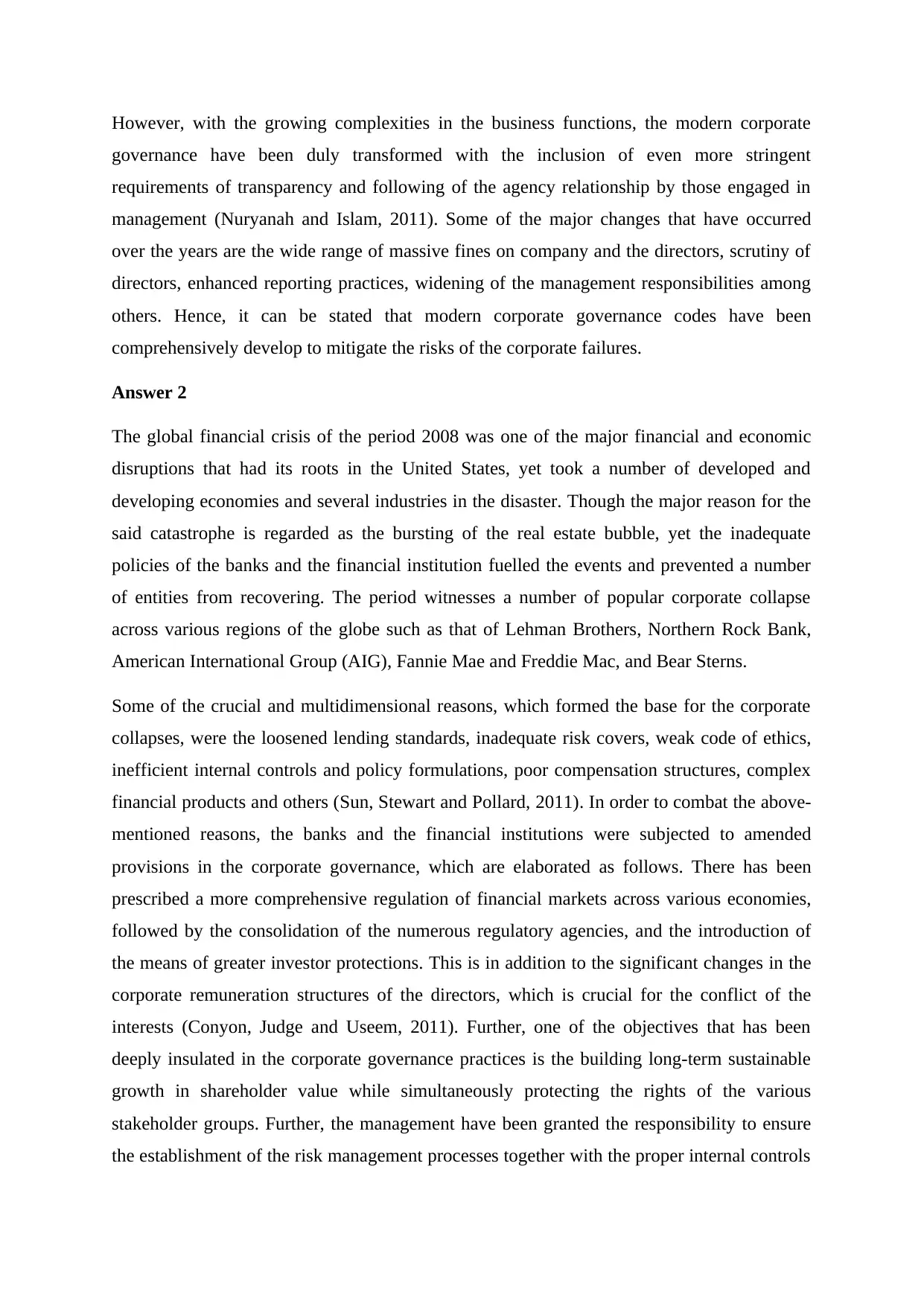
However, with the growing complexities in the business functions, the modern corporate
governance have been duly transformed with the inclusion of even more stringent
requirements of transparency and following of the agency relationship by those engaged in
management (Nuryanah and Islam, 2011). Some of the major changes that have occurred
over the years are the wide range of massive fines on company and the directors, scrutiny of
directors, enhanced reporting practices, widening of the management responsibilities among
others. Hence, it can be stated that modern corporate governance codes have been
comprehensively develop to mitigate the risks of the corporate failures.
Answer 2
The global financial crisis of the period 2008 was one of the major financial and economic
disruptions that had its roots in the United States, yet took a number of developed and
developing economies and several industries in the disaster. Though the major reason for the
said catastrophe is regarded as the bursting of the real estate bubble, yet the inadequate
policies of the banks and the financial institution fuelled the events and prevented a number
of entities from recovering. The period witnesses a number of popular corporate collapse
across various regions of the globe such as that of Lehman Brothers, Northern Rock Bank,
American International Group (AIG), Fannie Mae and Freddie Mac, and Bear Sterns.
Some of the crucial and multidimensional reasons, which formed the base for the corporate
collapses, were the loosened lending standards, inadequate risk covers, weak code of ethics,
inefficient internal controls and policy formulations, poor compensation structures, complex
financial products and others (Sun, Stewart and Pollard, 2011). In order to combat the above-
mentioned reasons, the banks and the financial institutions were subjected to amended
provisions in the corporate governance, which are elaborated as follows. There has been
prescribed a more comprehensive regulation of financial markets across various economies,
followed by the consolidation of the numerous regulatory agencies, and the introduction of
the means of greater investor protections. This is in addition to the significant changes in the
corporate remuneration structures of the directors, which is crucial for the conflict of the
interests (Conyon, Judge and Useem, 2011). Further, one of the objectives that has been
deeply insulated in the corporate governance practices is the building long-term sustainable
growth in shareholder value while simultaneously protecting the rights of the various
stakeholder groups. Further, the management have been granted the responsibility to ensure
the establishment of the risk management processes together with the proper internal controls
governance have been duly transformed with the inclusion of even more stringent
requirements of transparency and following of the agency relationship by those engaged in
management (Nuryanah and Islam, 2011). Some of the major changes that have occurred
over the years are the wide range of massive fines on company and the directors, scrutiny of
directors, enhanced reporting practices, widening of the management responsibilities among
others. Hence, it can be stated that modern corporate governance codes have been
comprehensively develop to mitigate the risks of the corporate failures.
Answer 2
The global financial crisis of the period 2008 was one of the major financial and economic
disruptions that had its roots in the United States, yet took a number of developed and
developing economies and several industries in the disaster. Though the major reason for the
said catastrophe is regarded as the bursting of the real estate bubble, yet the inadequate
policies of the banks and the financial institution fuelled the events and prevented a number
of entities from recovering. The period witnesses a number of popular corporate collapse
across various regions of the globe such as that of Lehman Brothers, Northern Rock Bank,
American International Group (AIG), Fannie Mae and Freddie Mac, and Bear Sterns.
Some of the crucial and multidimensional reasons, which formed the base for the corporate
collapses, were the loosened lending standards, inadequate risk covers, weak code of ethics,
inefficient internal controls and policy formulations, poor compensation structures, complex
financial products and others (Sun, Stewart and Pollard, 2011). In order to combat the above-
mentioned reasons, the banks and the financial institutions were subjected to amended
provisions in the corporate governance, which are elaborated as follows. There has been
prescribed a more comprehensive regulation of financial markets across various economies,
followed by the consolidation of the numerous regulatory agencies, and the introduction of
the means of greater investor protections. This is in addition to the significant changes in the
corporate remuneration structures of the directors, which is crucial for the conflict of the
interests (Conyon, Judge and Useem, 2011). Further, one of the objectives that has been
deeply insulated in the corporate governance practices is the building long-term sustainable
growth in shareholder value while simultaneously protecting the rights of the various
stakeholder groups. Further, the management have been granted the responsibility to ensure
the establishment of the risk management processes together with the proper internal controls
⊘ This is a preview!⊘
Do you want full access?
Subscribe today to unlock all pages.

Trusted by 1+ million students worldwide
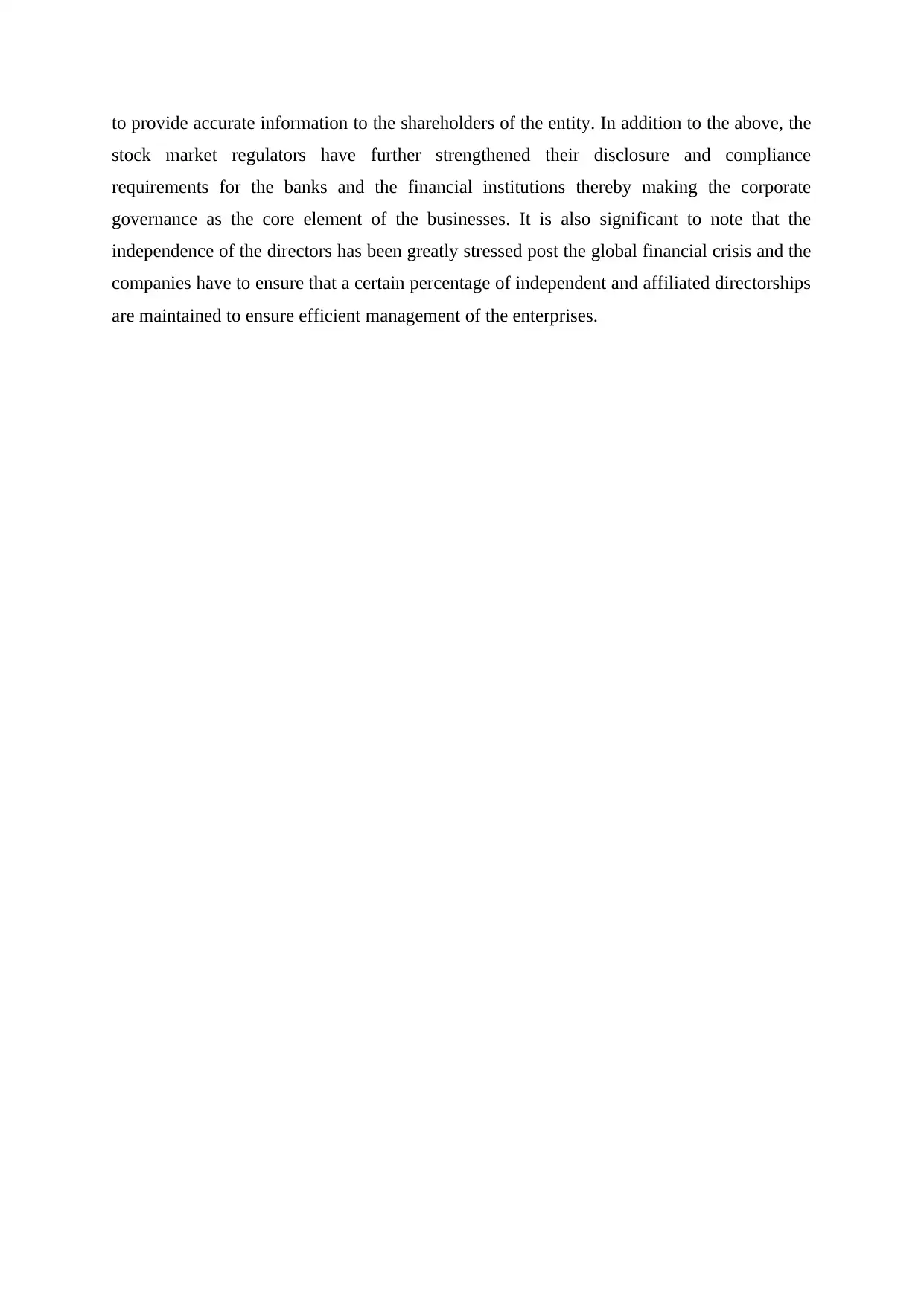
to provide accurate information to the shareholders of the entity. In addition to the above, the
stock market regulators have further strengthened their disclosure and compliance
requirements for the banks and the financial institutions thereby making the corporate
governance as the core element of the businesses. It is also significant to note that the
independence of the directors has been greatly stressed post the global financial crisis and the
companies have to ensure that a certain percentage of independent and affiliated directorships
are maintained to ensure efficient management of the enterprises.
stock market regulators have further strengthened their disclosure and compliance
requirements for the banks and the financial institutions thereby making the corporate
governance as the core element of the businesses. It is also significant to note that the
independence of the directors has been greatly stressed post the global financial crisis and the
companies have to ensure that a certain percentage of independent and affiliated directorships
are maintained to ensure efficient management of the enterprises.
Paraphrase This Document
Need a fresh take? Get an instant paraphrase of this document with our AI Paraphraser
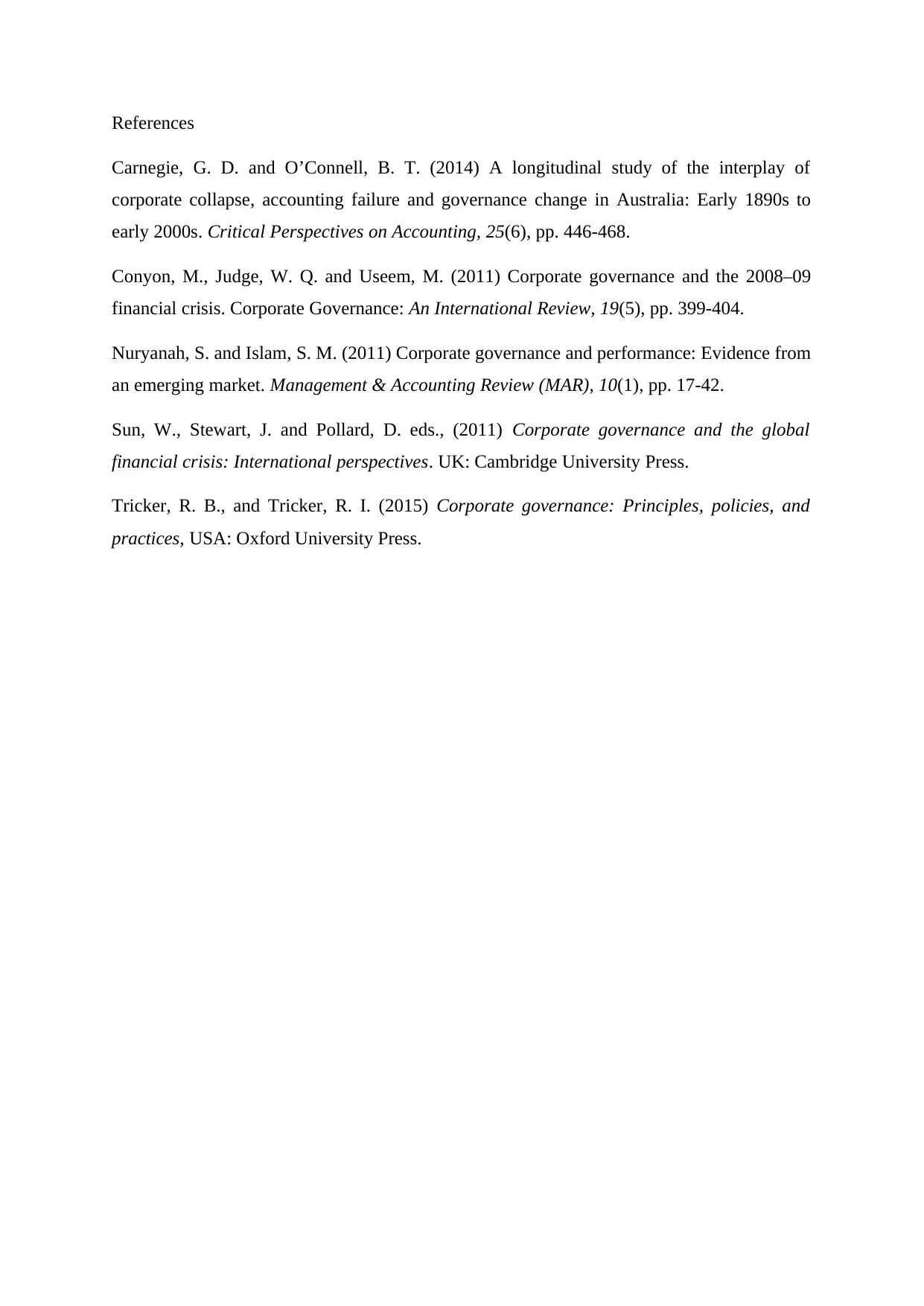
References
Carnegie, G. D. and O’Connell, B. T. (2014) A longitudinal study of the interplay of
corporate collapse, accounting failure and governance change in Australia: Early 1890s to
early 2000s. Critical Perspectives on Accounting, 25(6), pp. 446-468.
Conyon, M., Judge, W. Q. and Useem, M. (2011) Corporate governance and the 2008–09
financial crisis. Corporate Governance: An International Review, 19(5), pp. 399-404.
Nuryanah, S. and Islam, S. M. (2011) Corporate governance and performance: Evidence from
an emerging market. Management & Accounting Review (MAR), 10(1), pp. 17-42.
Sun, W., Stewart, J. and Pollard, D. eds., (2011) Corporate governance and the global
financial crisis: International perspectives. UK: Cambridge University Press.
Tricker, R. B., and Tricker, R. I. (2015) Corporate governance: Principles, policies, and
practices, USA: Oxford University Press.
Carnegie, G. D. and O’Connell, B. T. (2014) A longitudinal study of the interplay of
corporate collapse, accounting failure and governance change in Australia: Early 1890s to
early 2000s. Critical Perspectives on Accounting, 25(6), pp. 446-468.
Conyon, M., Judge, W. Q. and Useem, M. (2011) Corporate governance and the 2008–09
financial crisis. Corporate Governance: An International Review, 19(5), pp. 399-404.
Nuryanah, S. and Islam, S. M. (2011) Corporate governance and performance: Evidence from
an emerging market. Management & Accounting Review (MAR), 10(1), pp. 17-42.
Sun, W., Stewart, J. and Pollard, D. eds., (2011) Corporate governance and the global
financial crisis: International perspectives. UK: Cambridge University Press.
Tricker, R. B., and Tricker, R. I. (2015) Corporate governance: Principles, policies, and
practices, USA: Oxford University Press.
1 out of 5
Related Documents
Your All-in-One AI-Powered Toolkit for Academic Success.
+13062052269
info@desklib.com
Available 24*7 on WhatsApp / Email
![[object Object]](/_next/static/media/star-bottom.7253800d.svg)
Unlock your academic potential
Copyright © 2020–2025 A2Z Services. All Rights Reserved. Developed and managed by ZUCOL.





